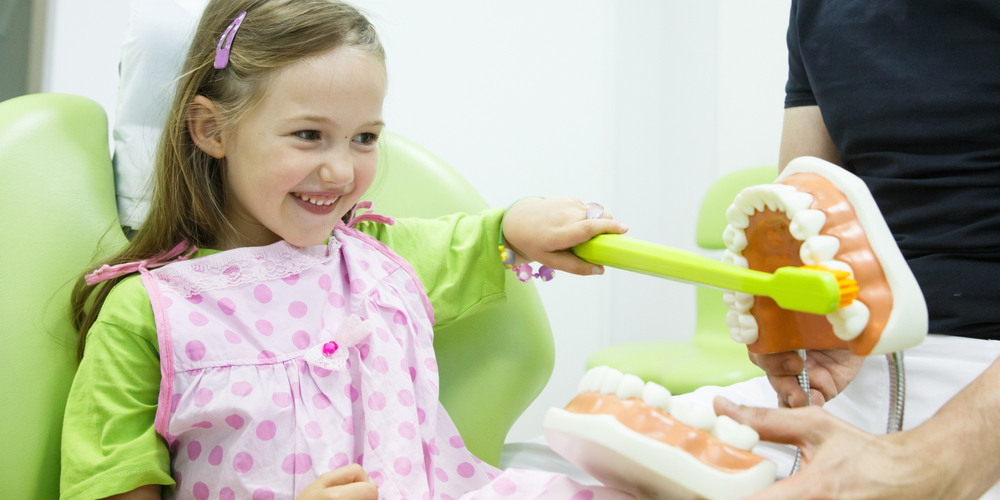
Paediatric dentistry aims to improve the dental health of babies, children and teenagers by means of education and preventative services. This is a broad based specialism which involves general dentistry and other areas such as orthodontics, oral and maxillofacial surgery and oral medicine.
This section includes two important subjects related to paediatric dentistry:
- Childhood dental conditions
- Childhood dental care
Find out more about these two sub-sections.
CHALLENGES OF PAEDIATRIC DENTISTRY
This specialism requires high level dental and communication skills especially when dealing with children who often present with conditions unique to them. They may have a congenital deformity, undergo some form of dental trauma or are classed as special needs.
Plus many children are resistant to dental treatment and have developed dental phobia as a result. Care and encouragement is needed to ensure that they avoid dental treatment to the extent that it endangers their health.
CHILDHOOD DENTAL CONDITIONS
There are dental conditions which particularly affect children and teenagers and if left untreated, will cause problems when they reach adulthood.
These conditions are:
- Tooth decay
- Gum disease
- Tooth erosion
Conditions such as tooth decay are caused by bacteria which attack the hard outer surface (or enamel), causing a cavity to develop on this surface. The bacteria then attack the soft internal structures of the tooth such as the pulp and eventually destroy the nerves and blood vessels within. The tooth then dies and either falls out or has to be removed.
Find out more in the tooth decay section.
Gum disease is another condition which can develop in young children as well as adults. There are two versions: gingivitis and periodontitis, with periodontitis being the more serious of the two. It is caused by plaque and bacteria which irritate the gums, causing redness, inflammation and bleeding when brushed.
If gingivitis is allowed to develop into periodontitis then this causes the gums to recede which worsen the infection. This then spreads to the jawbone causing it to shrink and the tooth to loosen. This tooth will eventually fall out.
Find out more in the gum disease section.
Tooth erosion differs to tooth decay in that it is not caused by bacteria or plaque: instead it is caused by over consumption of sweet or fizzy drinks which are known to be acidic, and this acidity wears away the surface of the teeth. The end result is a badly worn or damaged tooth and an exposed middle layer (dentin).
Other dental conditions include dental injuries which often occur as a result of rough and tumble or high energy activities. These injuries include teeth which have been knocked out; cracked or chipped teeth or a fractured jaw (or other facial injuries).
CHILDHOOD DENTAL CARE
It is important that children clean and care for their teeth from a very early age. The sooner they get into good habits the better as following a daily dental hygiene routine will pay dividends in the long term. This includes being taken to the dentist as soon as they are old enough where they will learn about dental care as well as building a relationship with the dentist.
Around 30% of children aged 5 have tooth decay. And just over 30% of children aged 12 show signs of dental decay.
This is a relatively low percentage but the fact remains that it is important that children and teenagers acquire good dental habits as soon as they are able to. This means cleaning their teeth at least twice a day (or after every meal), visiting their dentist every 6 months and reducing their intake of sugary drinks and foods.
Introduce babies to dental care by brushing their gums very gently or letting them play with a toothbrush. This will familiarise them with this routine. Brush their teeth only when the milk teeth have erupted.
Toddlers (under 3) can be shown how to use a toothbrush. They can use a child’s toothbrush with a tiny amount of toothpaste. This will encourage them to adopt this routine. Take your toddler to the dentist so that they become familiar with this environment and view it in a positive manner. They will become relaxed and confident at doing so.
Supervise the child until they are old enough to do this for themselves. Ensure that they know how to clean their teeth and for at least 2 minutes.
Limit the amount of fizzy drinks, sweets and other sugary foods and encourage them to brush their teeth each time they consume these. Also encourage them to swap these for healthy snacks such as fresh fruit. Avoid fruit juices and bedtime drinks such as chocolate which contain sugar.